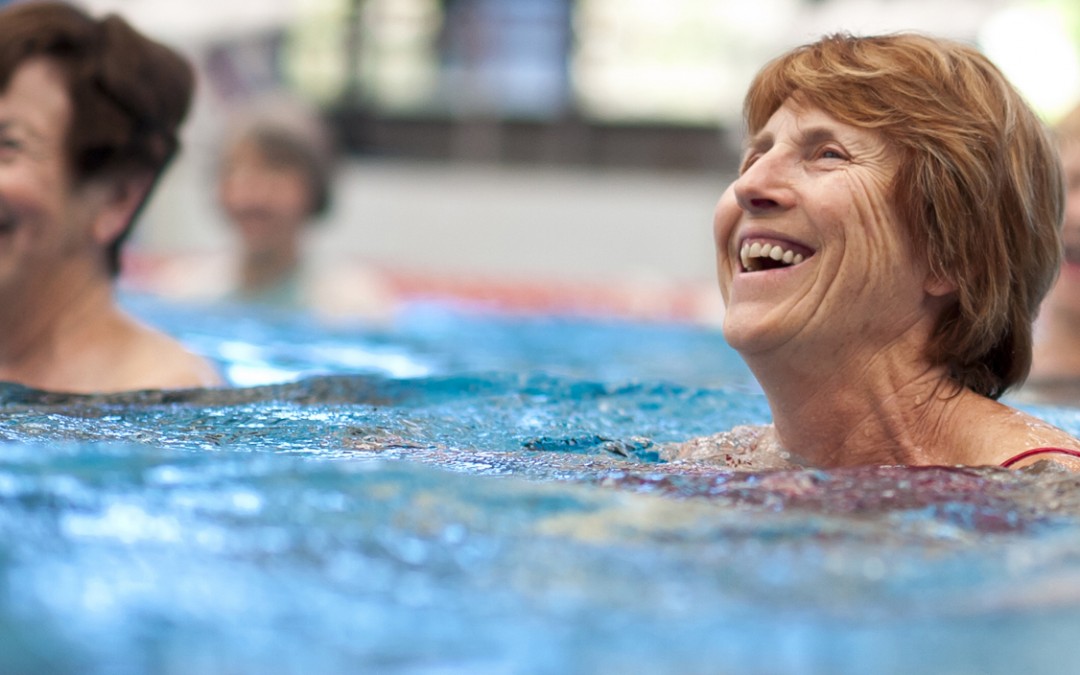BY ELLEN NORDBERG
Garry Killgore, PhD, professor of human performance and former cross-country coach at Linfield College, agrees. “Water is an excellent alternative for baby boomers and ex-athletes, and there is more and better science behind the use of water as an adjunct to normal training.”
Success Stories
Killgore also cites examples of elite athletes who train by running in deep water. “I have consistently and successfully used water running…for my runners,” he states. “Marci Gage, a 2016 Olympic Trials qualifier in the marathon, uses water running and related water drills as a supplement to her land-based running at least two to five times per week.”
Another example is Mary Ritter, a marathon runner and triathlete in Lafayette, Colo. Ritter’s Ironman® training was sidelined by a stress fracture. “I was in a boot for eight weeks,” she shares, “giving me only four months to get to where I could finish a marathon.”
She discovered the Fluid Running® Method, and achieved outstanding results. “I was able to do my Ironman with no foot pain, and had a personal record in terrible windy and rainy conditions,” she reports.
Hooked on water training, Ritter became a certified Fluid Running instructor. She continues to cross-train by running two days a week in the water and three days on land.
Formats
Runners find cross-training and injury rehab in the pool beneficial, but many non-runners also appreciate water running classes for the intense workouts.
“We combine low-to-moderate aerobic running sets with high-intensity intervals and sprints,” says Jennifer Conroyd, owner of Fluid Running. “We keep rest short, as heart rates drop quickly when vertical in the deep water. The combination of low-to-moderate and high-intensity sets results in both fat and calorie burning.”
Flotation Devices
“Appropriate buoyancy must be provided for the runner to best mimic land-based running form,” insists Killgore. “Runners typically do not carry enough fat in order to float correctly and perform proper running technique.”
Vendors such as Speedo®, AquaJogger®, Kiefer®, Hydro-fit®, Sprint Aquatics® and WaterGym® sell flotation belts in a variety of shapes and sizes.
“The primary goal of a belt is to offer neutral buoyancy,” adds Lori Sherlock, associate professor of exercise physiology at West Virginia University and Aquatic Exercise Association training specialist. “Everyone will have different buoyancy levels, as well as varied distribution of buoyancy on their bodies. Having a selection [of belts] for participants to choose from is beneficial.”
Certifications
Experts agree certifications should be required for water running instructors. “Just because a coach is good at training runners on land does not mean that will carry over automatically to water,” Killgore explains. “Instructors should be exposed to true proper running form both in the water and on land.”
The Aquatic Exercise Association offers in-depth water fitness certifications, and Conroyd’s Fluid Running provides a water running-specific certification. “There is a lot to understand about the physiological effects of working out vertically in the deep water,” Conroyd observes. “For example, heart rates are about 10 to 15 beats per minute lower.”
Correct Form
Proper water running form is key, although definitions vary. “With the Fluid Running Method, the participant mimics land running form—a vertical body with legs under hips moving forward and backward, replicating land running biomechanics,” Conroyd clarifies. “Traditional aqua jogging often has participants pulling their knees up to their chest. Who runs like that? We’re constantly saying, ‘Shoulders back, belly to spine, legs underneath you.’”
While Fluid Running classes use a tether to help maintain the runner’s vertical position, other class formats can involve travel through the water.
Killgore believes water should be at shoulder level with the body in vertical position and leaning slightly forward, similar to “running hard up a slight hill.” He adds, “Do not bend at the waist—strive for a total-body lean from the ankles.”
Killgore’s cues include: Relax your shoulders, run into a headwind, swing arms from the shoulders and drive the elbows back, and imagine tearing up the bottom surface of the pool with the balls of your feet.
Sherlock believes correct form depends on the client. “If an athlete utilizes running in their sport, the goal would be to mimic the running form they use on land,” she notes. “On the other hand, if I have an individual interested in general fitness, an emphasis on range of motion and vertical body position would be the focus.”
“From elderly women to elite athletes, all populations can show advancements in fitness when engaged in the right type of water running class.”
Contraindications
Water running workouts hold tremendous benefits, but may not be for everyone. While many athletes use water training to rehab an injury, it’s important to respect a safe recovery window. Post-surgery participants should have their doctor’s permission. Certain knee or hip injuries could be aggravated by water resistance. Chewning cautions instructors to be wary of people who can’t swim or are fearful in the water, and that people with chronic conditions such as heart disease may need specified intensity levels.
Multilevel, Effective and Fun
“Deep water running classes are attractive to people of all fitness levels,” Sherlock says. “From elderly women to elite athletes, all populations can show advancements in fitness when engaged in the right type of water running class. I’ve had a 90 year old with a pacemaker exercising next to a collegiate athlete. Deep water running is fun, feels good and shows results.” AF

